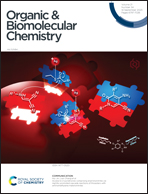Balancing ring and stopper group size to control the stability of doubly threaded [3]rotaxanes†
Abstract
Synthesizing doubly threaded [3]rotaxanes requires the use of larger rings than more traditional singly threaded [2]rotaxanes. A key challenge in accessing stable doubly threaded [3]rotaxanes with large rings is finding the right combination of ring to stopper size. In this study, a series of doubly threaded [3]rotaxanes derived from five different sized macrocycles in the size range of 40–48 atoms and two different stopper groups, which contain 1 or 2 tris(p-t-butylbiphenyl)methyl moieties, were prepared and their kinetic stability examined. These interlocked compounds were synthesized using a metal-templated approach and fully characterized utilizing a combination of mass spectrometry, NMR spectroscopy, and size-exclusion chromatography techniques. The effect of ring size on the stability of the doubly threaded [3]rotaxane was investigated via kinetic stability tests monitored using 1H-NMR spectroscopy. By tightening the macrocycle systematically every 2 atoms from 48 to 40 atoms, a wide range of doubly threaded interlocked molecules could be accessed in which the rate of room temperature slippage of the macrocycle from the dumbbells could be tuned. Using the larger stopper group with a 48-atom ring results in no observable rotaxane, 46–44 atom macrocycles result in metastable rotaxane species with a slippage half-life of ∼5 weeks and ∼9 weeks, respectively, while macrocycles of 42 atoms or smaller yield a stable rotaxane. The smaller sized stopper is not able to fully stabilize any of the [3]rotaxane structures but metastable [3]rotaxanes are obtained with slippage half-lives of 25 ± 2 hours and 13 ± 1 days using macrocycles with 42 or 40 atoms, respectively. These results highlight the dramatic effect that relatively small ring size changes can have on the structure of doubly threaded [3]rotaxanes and lay the synthetic groundwork for a range of higher order doubly threaded interlocked architectures.
![Graphical abstract: Balancing ring and stopper group size to control the stability of doubly threaded [3]rotaxanes](/en/Image/Get?imageInfo.ImageType=GA&imageInfo.ImageIdentifier.ManuscriptID=D3OB01123B&imageInfo.ImageIdentifier.Year=2023)


 Please wait while we load your content...
Please wait while we load your content...